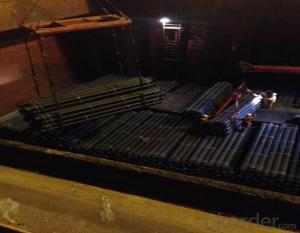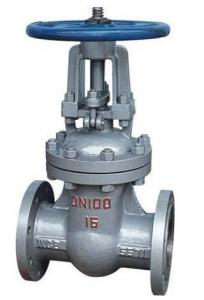DUCTILE IRON PIPE C Class DN100
- Loading Port:
- China Main Port
- Payment Terms:
- TT OR LC
- Min Order Qty:
- -
- Supply Capability:
- -
OKorder Service Pledge
OKorder Financial Service
You Might Also Like
Ductile Iron Cast Pipe is without any defects compare with tradition casting tech, which has many advantages particularly as follow:
(1) High density. In the "vertical upward casting" process, the melt iron of centre liquid column in center crystallizer is continuously feeding for volume shrinkage caused by condensation tube at outer circumference , which lead to be free of shrinkage porosity.
(2) High purity. When melt iron pouring, the mixed impurities such as gas, dross, sand grain which are lighter than melt iron could be eliminated at furnace mouth, its impossible to enter into the crystallizer through the channel, so the melt iron into the crystallizer is very pure.
(3) Strength with toughness. The cooling speed provided by continuous crystallizer is 30 times than sand casting and 5 times than centrifugal casting, and doesn't produce white iron, the eutectic cell volume of continuous cast iron is one eighth to one tenth compare with traditional cast iron. The density of graphite nodule in ductile iron can reach 300-700 pcs/mm2. Therefore, all reason above improve the strength and toughness of continuous cast iron.
(4) Free machining. The high speed cooling make the hardening phase (such as boride, steadite) not appear like reticular, massive or thick, but diffuse like fish bone and pane in shape, moreover, there are tiny graphite flakes inlaid hardening phase. It's free machining in BrinellHardness the range of 250-300HB. However, the Brinell Hardness of 250 is top limit to common metal materials.
(5) Uniform composition of tube wall. The convection mixing of liquid column caused by marching type drawing in crystallizer make the composition of tube wall well-distributed, and concentration gradient very little.
(6) High productivity. To the wall thickness of tube under 10mm, the speed of continuous casting is 1 meter/min, to the wall thickness of tube under 20mm, the speed of continuous casting is 0.5 meter/min, which is high efficiency that centrifugal or other casting tech couldn't reach.
- Q:What's the function of the cement mortar lining of ductile iron pipes?
- You may easily say that this statement is vague and there is no evidence that other manufacturers often do so when promoting other types of lining. However, in order to prove the truth of the above view, we have compiled sufficient examples to demonstrate the reliability of each of these statements from a scientific and logical point of view.We have stated each of these fields and other embedded systems as specious statements. There is only a reasonable conclusion that the cement mortar lining (CML) provides excellent protection for ductile iron pipes and steel tubes.Ductile iron pipe and steel pipe CML CML produces a synergistic effect of the incomparable.
- Q:Are ductile iron pipes suitable for irrigation systems in agricultural fields?
- Yes, ductile iron pipes are suitable for irrigation systems in agricultural fields. Ductile iron pipes have excellent strength, durability, and corrosion resistance, making them ideal for carrying water in irrigation systems. They can withstand high pressure and heavy loads, ensuring reliable water supply to agricultural fields for irrigation purposes.
- Q:Are ductile iron pipes resistant to corrosion?
- Yes, ductile iron pipes are highly resistant to corrosion.
- Q:How long do ductile iron pipes last?
- Ductile iron pipes possess an impressive durability and extended lifespan. Typically, these pipes can endure from 80 to 100 years, with certain instances even reaching an impressive 150 years. The exceptional longevity of ductile iron pipes can be attributed to their sturdy construction, enabling them to withstand high-pressure surroundings, combat corrosion, and endure severe weather conditions. Furthermore, ductile iron pipes have established a commendable reputation for their reliability and performance, rendering them a favored option for water and wastewater infrastructure projects worldwide. By conducting regular inspections and implementing maintenance measures, the lifespan of ductile iron pipes can be further prolonged, assuring their continued service for numerous decades to come.
- Q:What is the weight of ductile iron pipes compared to other materials?
- Compared to other commonly used materials in the construction industry, ductile iron pipes tend to be heavier. The weight of these pipes can vary depending on their specific size and dimensions, but they are usually heavier than materials like PVC, HDPE, and steel pipes. The primary reason for this increased weight is the dense nature of ductile iron, which grants it durability, strength, and resistance to corrosion. However, this weight also presents challenges in terms of transportation, installation, and handling, necessitating appropriate equipment and techniques for safe and efficient installation. Despite being heavier, ductile iron pipes offer numerous advantages in terms of longevity and performance in various applications.
- Q:How do ductile iron pipes handle ground settlement near construction sites?
- Ductile iron pipes are highly resilient and can withstand ground settlement near construction sites. Due to their flexible nature, these pipes can accommodate small movements and settlement without incurring significant damage or failure. The ductility of the material allows the pipes to bend and adjust to the changing ground conditions, ensuring their integrity and minimizing the risk of leaks or breakage. Additionally, the strong and durable properties of ductile iron make it a reliable choice for underground infrastructure, providing long-term stability even in challenging environments.
- Q:Can ductile iron pipes be used for irrigation pivot systems?
- Yes, ductile iron pipes can be used for irrigation pivot systems. Ductile iron pipes have high tensile strength and durability, making them suitable for handling the pressure and load requirements of irrigation pivot systems. Additionally, their corrosion resistance makes them a reliable choice for long-term use in such applications.
- Q:Method for cutting large diameter ductile iron pipe
- When the ratio of oxygen to acetylene is 1 to 1.2, the flame produced is called neutral flame, also known as normal flame. It consists of flame core, inner and outer flame: near the welding nozzle at the flame core, a bright white; followed by the flame, a blue purple, the highest temperature, about 3150 DEG C, from the front cone at 2 ~ 4mm, and the application of welding wire to the workpiece; the outer flame is orange red. Neutral flame is a flame commonly used in welding. It is used to weld low carbon steel, medium carbon steel, alloy steel, copper and aluminum alloy.
- Q:What are the different methods for joining ductile iron pipe?
- There exists a variety of methods to join ductile iron pipe, each possessing its own advantages and limitations. One commonly utilized technique is the mechanical joint (MJ) coupling, where a rubber gasket, bolts, and nuts are employed to establish a watertight seal between pipe sections. This method is comparatively swift and straightforward to install, although it necessitates the expertise of a skilled technician to ensure proper alignment and bolt tightening to prevent leakage. Another approach is the flanged joint, which involves equipping the pipe ends with flanges that are fastened together using gaskets to form a secure seal. This method permits easy disassembly and reassembly of pipe sections, making it suitable for applications requiring frequent maintenance or alterations. However, it is more costly and time-consuming when compared to other methods. A widely employed method is the push-on joint (POJ), wherein a rubber gasket and a special lubricant are utilized to slide the pipe ends together. This technique yields a reliable and watertight seal, and installation is relatively rapid and simple. However, it necessitates proper alignment and cautiousness to prevent damage to the gasket during assembly. An alternative option is the restrained joint (RJ), which utilizes a mechanical joint coupling with additional features to resist axial forces or thrusts. This method is commonly employed in applications where the pipe is subjected to internal pressure, external loads, or seismic activity. It offers a secure and rigid connection but may require specialized tools and training for installation. Lastly, welding is another method for joining ductile iron pipe. This involves heating the pipe ends and melting a filler metal to create a permanent bond. Welding provides a strong and durable connection, but it demands skilled welders and additional time for preparation, welding, and cooling. It is often employed for specific applications, such as joining sections of pipe with different diameters or connecting to other materials. In conclusion, the various methods for joining ductile iron pipe encompass mechanical joint coupling, flanged joint, push-on joint, restrained joint, and welding. The selection of the method relies on factors such as application requirements, installation time, maintenance needs, and budget.
- Q:What is the maximum operating pressure for ductile iron pipes?
- The maximum operating pressure of ductile iron pipes may vary based on factors like pipe diameter, wall thickness, and the specific usage. Nonetheless, typically, ductile iron pipes are engineered to endure pressures of up to 350 psi (pounds per square inch), and occasionally even higher. It is worth highlighting that to ascertain the precise maximum operating pressure for a specific ductile iron pipe system, one should refer to local regulations, engineering standards, and manufacturer specifications.
1. Manufacturer Overview |
|
|---|---|
| Location | |
| Year Established | |
| Annual Output Value | |
| Main Markets | |
| Company Certifications | |
2. Manufacturer Certificates |
|
|---|---|
| a) Certification Name | |
| Range | |
| Reference | |
| Validity Period | |
3. Manufacturer Capability |
|
|---|---|
| a)Trade Capacity | |
| Nearest Port | |
| Export Percentage | |
| No.of Employees in Trade Department | |
| Language Spoken: | |
| b)Factory Information | |
| Factory Size: | |
| No. of Production Lines | |
| Contract Manufacturing | |
| Product Price Range | |
Send your message to us
DUCTILE IRON PIPE C Class DN100
- Loading Port:
- China Main Port
- Payment Terms:
- TT OR LC
- Min Order Qty:
- -
- Supply Capability:
- -
OKorder Service Pledge
OKorder Financial Service
Similar products
New products
Hot products
Related keywords


























